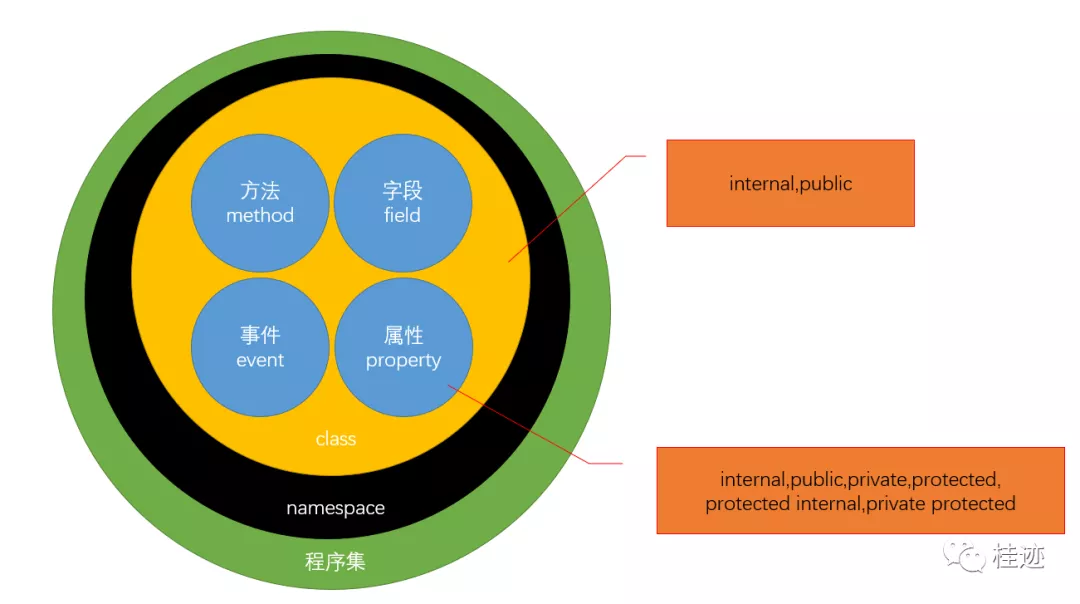.NET架构小技巧(2)——访问修饰符正确姿势
在C#中,访问修饰符是使用频率很高的一组关键字,一共四个单词六个组合:public,internal,protected internal,protected,private protected,private,如果你对这些关键字非常清楚,请跳过,节省时间;如果你在编程中一般都使用public和private,那不防花点时间来明确一下,方便设计功能模块时准备使用。

如果简单的分层.net程序集(dll,exe)的话,如上图,修饰符用在自定义类型前和类内部的成员前(方法,属性,字段等),自定义类型只能使用internal和public,类内部成员七种修饰符都可以使用的。
接下来,唠叨一下七种使用场景:
public:这个什么场景都可以使用
internal:只能在当前的应用程序集内使用
protected:只能在子类中使用父类中的protected成员
private:只能在当前类中使用private成员
protected internal:在当前程序集内使用和不在一个程序集内的子类中使用
private protected:只能在当前程序集内的子类中使用
准确的使用访问修饰符,可以很好的封装对象的功能,该对外暴露的暴露,该开放的开放,开放的多彻底都可以控制。
例如:
public class Program
{
static void Main(string[] args)
{
var myList = new MyList<int>();
myList.Add(1);
myList.Add(2);
myList.Add(3);
myList.Add(4);
myList.Add(5);
foreach (var o in myList)
{
Console.WriteLine(o);
}
}
}
public class MyList<T> : IEnumerable
{
protected T[] array;
public MyList()
{
array = new T[4];
}
public int Count
{
get;
private set;
} = 0;
public void Add(T t)
{
if (array.Length == Count)
{
array = CreateNewArray(array, Count * 2);
}
array[Count] = t;
Count++;
}
public IEnumerator GetEnumerator()
{
for (int i = 0; i < Count; i++)
{
yield return array[i];
}
}
private T[] CreateNewArray(T[] oldArray, int length)
{
var newArray = new T[length];
oldArray.CopyTo(newArray, 0);
return newArray;
}
}
其中,CreateNewArray方法只在内部使用,所以是Private;Add方法是供外部添加元素的,public;Count属性get是对外提供元素的个数,但set是私有的,不能在外部对它赋值;字段array按理该是private,这里我想让子类能访问到,以便提供更大的访问权限,官方的List<T>是private的,子类中是看不见这个数据的。这个例子就能很好的说明:准确的使用访问修饰符,可以很好的封装对象的功能,该对外暴露的暴露,该开放的开放。
另一方面,规(节)范(操)也很重要!






【推荐】国内首个AI IDE,深度理解中文开发场景,立即下载体验Trae
【推荐】编程新体验,更懂你的AI,立即体验豆包MarsCode编程助手
【推荐】抖音旗下AI助手豆包,你的智能百科全书,全免费不限次数
【推荐】轻量又高性能的 SSH 工具 IShell:AI 加持,快人一步
· 无需6万激活码!GitHub神秘组织3小时极速复刻Manus,手把手教你使用OpenManus搭建本
· C#/.NET/.NET Core优秀项目和框架2025年2月简报
· Manus爆火,是硬核还是营销?
· 一文读懂知识蒸馏
· 终于写完轮子一部分:tcp代理 了,记录一下